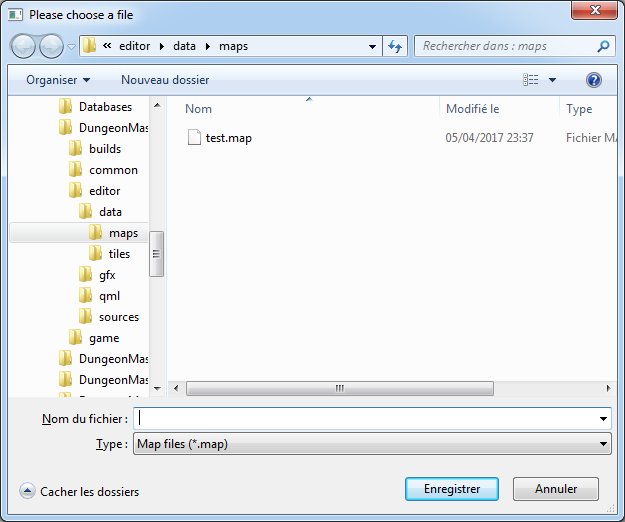Downloads
Executable for the map editor (Windows 32bits)
Executable for the game - exactly the same as in part 4 (Windows 32bits)
Before you try to compile the code go to the "Projects" tab on the left menu, select the "Run" settings for your kit,
and set the "Working directory" to the path of "editor\data" for the editor or "game\data" for the game.
What are we missing ?
for the walls, can we begin to draw a simple map in 3D ?
We are only missing one stage before that: a way to save the map from the editor and to load it in the game.
Additionnaly it will be useful for the editor to load maps that it has previously saved too.
We will put those two functions in "Map.cpp" that is in the "common" folder, so that the two projects can access them.
Even if the game itself will not use the save function it is a good idea to keep them together because they are symmetrical.
When you write a new file format it is usually better to start with an ASCII version that can be easily read in a text editor.
But the format of the maps is simple enough at this stage that we can write it in binary right now.
In this part we will focus on the loading and saving in the editor. Then loading the map in the game will reduce to a simple call to
the load function...
In the QML
FileDialog {
id: saveDialog
visible: false
title: "Please choose a file"
folder: "file:///maps"
nameFilters: [ "Map files (*.map)", "All files (*)" ]
selectExisting: false;
onAccepted: {
bridge.save(fileUrl);
visible=false;
}
onRejected: visible=false;
}
for the loading dialog.
When "visible" is set to true, those dialogs display a standard file selector:

A little bit under that, in main.qml, I modified the "file" menu:
Menu {
title: qsTr("File")
MenuItem {
text: qsTr("Load")
onTriggered: loadDialog.visible = true;
}
MenuItem {
text: qsTr("Save")
onTriggered: saveDialog.visible = true;
}
MenuItem {
text: qsTr("Exit")
onTriggered: Qt.quit();
}
}

In bridge.cpp
void CBridge::save(QString fileName)
{
// [8] to remove "file:///"
map.save(&fileName.toLocal8Bit().data()[8]);
}
void CBridge::load(QString fileName)
{
// [8] to remove "file:///"
map.load(&fileName.toLocal8Bit().data()[8]);
updateQMLImage();
}
In example we would get: "file:///E:/prg/DungeonMaster/editor/data/maps/test.map"
That's why you see a "&" character before "fileName" and "[8]" at the end because we skip 8 characters.
In Map.cpp
Here is the one that saves the map:
char gFileHeader[] = "DMMP"; // Dungeon Master MaP
#define CURRENT_VERSION 1
#define CURRENT_REVISION 0
void CMap::save(char* fileName)
{
FILE* handle = fopen(fileName, "wb");
uint16_t ver = CURRENT_VERSION;
uint16_t rev = CURRENT_REVISION;
if (handle != NULL)
{
// header, version, revision
fwrite(gFileHeader, 1, 4, handle);
fwrite(&ver, 2, 1, handle);
fwrite(&rev, 2, 1, handle);
// map size
fwrite(&mSize.x, 4, 1, handle);
fwrite(&mSize.y, 4, 1, handle);
// map data
for (int y = 0; y < mSize.y; ++y)
for (int x = 0; x < mSize.x; ++x)
{
CTile* t = getTile(CVec2(x, y));
fwrite(&t->mType, 1, 1, handle);
for (int side = 0; side < eWallSideMax; ++side)
fwrite(&t->mWalls[side].mType, 1, 1, handle);
}
fclose(handle);
}
}
First we write a 4 characters string "DMMP" so that it will be easy to see if this file contains map datas.
Then two 16bits values that contains a version and a revision number.
As we will probably make a lot of modifications to our file format in the future, it is important to know which version of the format
this file uses to avoid reading datas that don't exist or interpret them in a wrong way.
Then two 32bits values that tells the size of the map in tiles.
And finally, for each tile, we save it's type and the types of it's 4 walls, each on 1 byte.
The load() function is very similar, except that we check the values of the header and we allocate memory to read the map data.
In "editor/data/maps" I have included a very simple test map saved by this function.